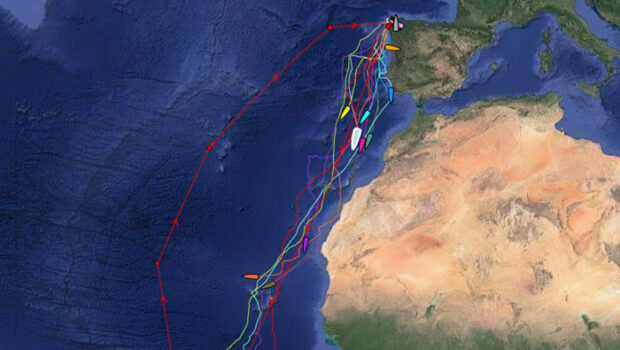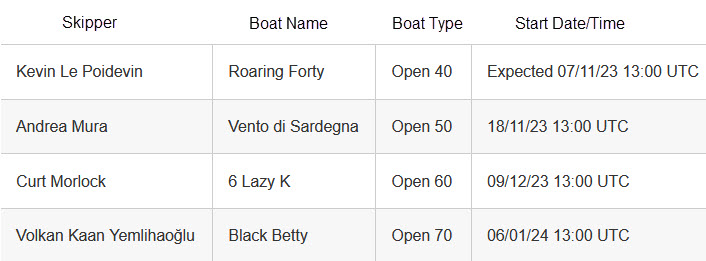Solo skippers descend the Atlantic
Published on November 2nd, 2023
With 14 of the 18 skippers having started the 2023-24 Global Solo Challenge following their pursuit time slot, first starter Dafydd Hughes (GBR) on his S&S 34 Bendigedig continues to lead the field as he begins his crossing of the Indian Ocean. North American entrants descending the Atlantic Ocean are William MacBrien’s Class40 Phoenix (7th), Ronnie Simpson’s Open 50 Shipyard Brewing (8th), Cole Brauer’s Class40 First Light (9th), and David Linger’s Class40 Koloa Maoli (12th).
Update from race organizers on November 2, 2023:
As the storm Ciaran hit the coast of Brittany last night with winds reaching 55-70 knots and red alerts in various French ports, the fleet of seven vessels from the Global Solo Challenge that left A Coruña on the morning of Sunday the 29th is heading south.
The conditions during the first days off the coast of Spain have been very tough. Riccardo Tosetto reported that near Cape Finisterre winds averaging 35 knots gusting to nearly 60 knots, with a rough sea and very difficult waves. All the skippers faced a real test of fire adapting to life at sea, not yet managing to find the right rhythm in navigation. Many have spoken of being exhausted and unable to rest due to the complicated weather conditions encountered, and for some, technical problems have also arisen.
Cole Brauer, the brave American skipper, the first to take to the sea among the seven competitors, chose the optimal route dictated by weather routing. When a cold front approaches, typically, the fastest route is to head west to intercept a cold front and take advantage of more favorable winds behind the front to head south.
However, in attempting to reach the front, the sea became increasingly difficult, making fast navigation tough with waves causing the boat to slam violently, which can quickly compromise the safety of the skipper and vessel.
Tacking again, Cole headed south, hoping to encounter milder wind conditions and a calmer and more manageable sea and sailing faster than her direct competitors by being the windward boat and able to crack off the sails for speed.
“Skippers must always look for the right balance between the optimal route estimated by navigation programs or the forecast to find favorable winds, with the state of the sea which, sometimes, prevents sailing at the desired or theoretically predicted speed,” said commented Marco Nannini, the creator and organizer of the GSC.
“The risk is damaging the boat without gaining a real advantage. In this case, fortunately, Cole reports gained precious miles relative to the direct competitors becoming the windward boat with no damage and in fact in this case it was actually the boats that were further east in the fleet that have encountered problems, they may have actually encountered a worse sea sate by not sailing off the continental shelf.”
American skipper Ronnie Simpson reported in his first blog post-departure that he faced some difficulties but was also happy about his rapid descent southward, hoping to soon encounter carrying winds and milder temperatures.
“I have encountered many initial problems to deal with onboard Shipyard Brewing, but I am also looking for solutions, planning my next moves. I would like to send a greeting to all the other skippers. So far, this is a magnificent adventure, but honestly, it has been quite tough.
“Now we cross the geographic and figurative boundary that takes us from the European winter heading towards warmer and milder latitudes which I hope will be some of the most enjoyable miles of the trip awaiting us. I look forward to the wind turning aft and being able to hoist the spinnakers, and I hope to solve the problems I’ve had on board. A toast from Shipyard Brewing, somewhere west of Gibraltar!”
The first to communicate a technical problem, on Tuesday morning (Oct. 31), was the Italian skipper Alessandro Tosetti aboard Aspra. Having started in a good position, in the first days, he sailed further east but not too far from Ronnie Simpson’s Open 50. During the second day of navigation, he began to have problems with the data network of the autopilot and, unable to resolve the issue at sea, he headed towards Matosinhos near Porto in Portugal.
Tosetti had hoped to anchor sheltered by the outer breakwater, but the port authorities asked him to move to the outer dock of the port. After evaluating the situation, Alessandro attempted to power the network directly from the pilot’s control unit, which, however, only works sporadically for periods of 10 to 30 minutes. He is waiting to get in touch with a technician to understand and definitively solve the problem.
Juan Merediz, aboard Sorolla, was leading the group of seven who had departed from Marina Coruña the previous Sunday (Oct. 29). By Tuesday afternoon, after two intense and difficult days of sailing, he had a problem with the mainsail halyard near Cascais and with the drive of the autopilot.
He continued sailing closer to the Portuguese coast to avoid further problems and on Wednesday night took shelter after Cabo San Vicente (Portugal) in the bay of Sagres to anchor and find shelter from the waves. He has already installed the spare autopilot drive but is checking what the problem was with the main unit, whose clutch works correctly but the internal motor does not seem to be receiving power. He hopes to resume his journey as soon as possible.
As Merediz communicated to his press officer and official photographer Pep Portas, “The weather conditions have been tough, especially the first night. Extreme conditions that have left their mark.” Messages of support are coming from all over Spain and Merediz, as an experienced navigator, will manage and quickly deal with the situation.
Good news from the Belgian skipper Édouard De Keyser, on SolarWind. After stopping for technical problems, he set off again on the afternoon of October 28 from Jacaré, in Brazil, heading for Cape of Good Hope. His boat suffered damages on several fronts: desalinator, autopilot, electrical system, carpentry, and sailmaking.
Despite these obstacles, Édouard has shown determination and psychological readiness to continue in the challenge. He plans to head towards Cape Town where he intends to carry out further repairs. He is in contact with an expert technician from Cape Town, already tasked with preparing Kirsten Neuschäfer’s boat for the Golden Globe Race 2022-23, whom Édouard hopes to meet.
The SolarWind team is mobilizing to launch a fundraising campaign in the hope of covering essential expenses. Edouard will be present via video conference at the important nautical festival “Into The Blue – Festival of the Sea” in Brussels.
Pavlin Nadvorni aboard Espresso Martini, informed the organization on Wednesday morning (Nov. 1) that he is heading towards an anchorage yet to be determined in the Cape Verde Islands. During the night of Tuesday, he was awakened by a failure in the autopilot ram. While he was busy getting the boat back on course, some ropes that fell overboard got tangled in the propeller shaft or knotted themselves together, getting stuck. Among these was the spinnaker halyard. Now, even though the spinnaker sock has been doused, the sail cannot be fully lowered.
“I have communicated to the organizers my decision to head towards an anchorage in one of the Cape Verde Islands, drop anchor and deal with these problems. In the meantime, I have reduced sail area and am sailing further east than the normal route, to ease the load on the spare actuator, which I mounted 15-20 minutes after last night’s failure. I am manually steering the boat for most of the day and will continue to do so in stretches, until my expected arrival on Thursday evening or night. It will be difficult to rest.”
A significant milestone for Louis Robein, on Le souffle de la mer III: October 30 at 6:31 am, he crossed the equator. Despite various problems with the hydrogenerator, which led to a drop in onboard energy that prevented him from communicating, the French skipper is coping with the problems independently, with the calm and expertise that distinguish him. We hope that, having passed through the challenging stretch of the Intertropical Convergence Zone, he can proceed at a good speed and find a good rhythm in his life onboard.
The next to depart from Spain will be Kevin Le Poidevin, the Australian skipper, who had to postpone his departure scheduled for October 28 due to a muscle strain in his back during the strenuous transfer from Falmouth to A Coruña. The organization will carry out safety checks onboard, and the skipper will be able to leave as soon as the weather conditions and his back pain allow it.
Kevin currently plans to depart on November 7, when there should be favorable conditions to rapidly gain miles southward and lessen the consequences of the delay in his departure. His health is improving, and the Australian is eager to leave and join the fleet of the other 14 navigators engaged in the great challenge of the GSC.
In the overall ranking calculated on the estimated time of arrival, Philippe Delamare maintains a firm lead, although Dafydd Hughes has closed the gap and is today on Bendigedig celebrating another milestone; he has covered one third of the total distance of the circumnavigation.
In third position, there is a new entry from the group of boats that left last Sunday: Ronnie Simpson on Shipyard Brewing has overtaken Ari Kansakoski on ZEROchallenge, recording the third-best estimated date of arrival. This is a theoretical calculation subject to continuous changes but will become more accurate as the event progresses.
Here are the remaining starters:
Race details – Entry list – Start times – Tracking
The inaugural Global Solo Challenge 2023-24 seeks to be a budget-friendly solo, non-stop race around the world. Using a pursuit format for the 2023-24 race, entrants from 34 to 70 feet will depart between August 26 to January 6 from A Coruña, Spain, with the first boat to return deemed the winner.










 We’ll keep your information safe.
We’ll keep your information safe.